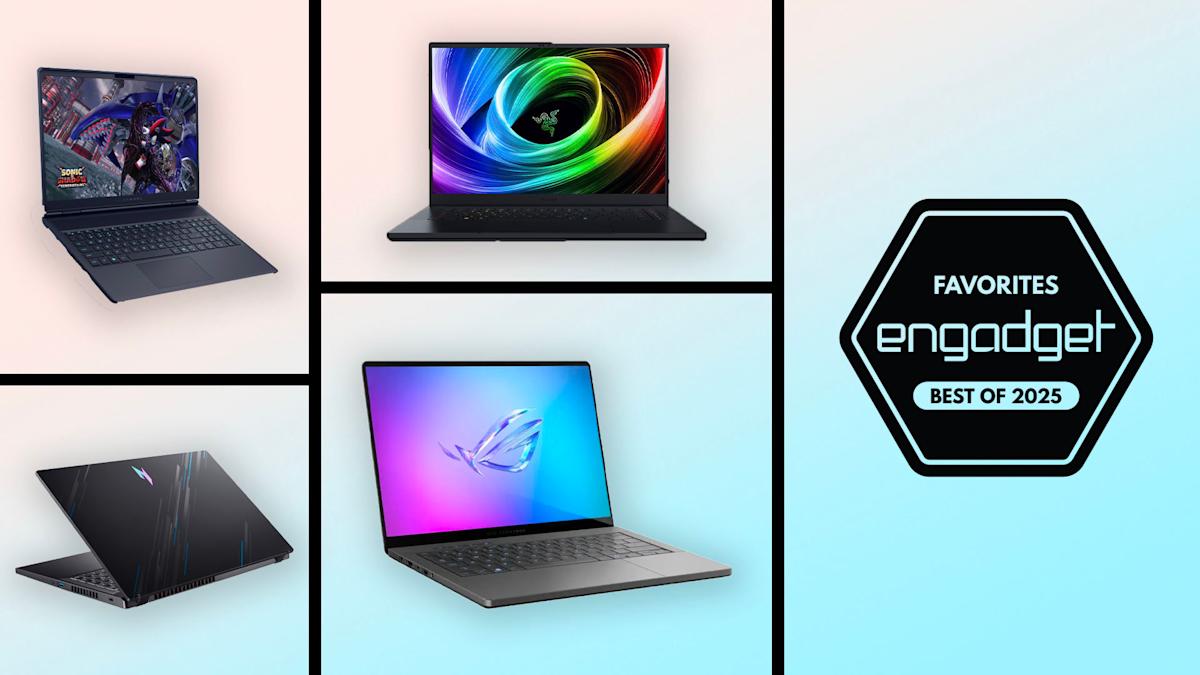The best laptops for gaming and schoolwork in 2025
The line between laptops built for gaming and those built for heavy-duty computing work has all but disappeared. These days, you don’t have to look too hard to find a not-so-flashy gaming notebook that could easily sit alongside MacBook Pros in a classroom. After all, a powerful CPU, video card and gobs of RAM will serve you well in both Clair Obscur and your video editing suite of choice.
In our guide for the best gaming laptops, you can find my overall suggestions on what to look for when it comes to hardware. But the notebooks I chose for that guide weren’t selected for their ability to blend into quieter environments like libraries and lecture halls. So if you’re looking for something without annoyingly loud fans and distracting LED lighting, read on for our top picks for the best laptops for schoolwork and gaming.
Best laptops for gaming and school in 2025
Display size: 14-inch OLED | Display resolution: 2560 x 1440 (QHD) | CPU:AMD Ryzen 9 8945HS | GPU: Nvidia GeForce RTX 4070 | RAM: 32GB LPDDR5X | Storage: 1TB SSD | Weight: 3.31 pounds | Max battery life: 10 hours
Read our full ASUS ROG Zephyrus G14 review
Perhaps I’m cheating a bit by recommending our favorite gaming laptop for this guide, but the Zephyrus G14 is simply that good. It’s relatively affordable, powerful enough for today’s games and it’s so elegantly designed it’s easy to forget it’s a gaming laptop. Last year’s revision added a refined unibody aluminum case, a gorgeous OLED screen and a weight reduction to just 3.3 pounds. The Zephyrus G14 feels curiously light for a machine with an AMD Ryzen 9 8945HS CPU and NVIDIA RTX 4070 graphics.
For 2025, ASUS also debuted Zephyrus G14 models featuring NVIDIA’s RTX 5070 GPU. You’ll certainly see more performance from the updated GPUs, but I think most people would be better off sticking with cheaper machines featuring NVIDIA’s last-gen hardware.
Display size: 16-inch OLED | Display resolution: 2560 x 1600 (QHD+) | CPU: AMD Ryzen AI 9 365 or AMD Ryzen AI 9 HX 370 | GPU: Nvidia GeForce RTX 5060 to 5090 | RAM: 16GB to 64GB LPDDR5X | Storage: 1TB to 4TB SSD | Weight: 4.7 pounds | Max battery life: 9 hours
Read our full Razer Blade 16 review
If you’re looking for something a bit more premium, the Razer Blade 16 is an excellent choice. Razer has honed its build quality to near perfection over the years, delivering the closest thing you’ll find to Apple’s MacBook Pro in the PC world. The Blade 16 is Razer’s thinnest laptop so far, and it can be configured with AMD’s powerful Ryzen AI 9 HX 370 chip and NVIDIA’s absurdly powerful RTX 5090 GPU. There’s also a 16-inch QHD+ 240Hz OLED display, which on paper sounds a lot more useful than the hybrid 1080p/4K screen Razer used to equip. Just be careful as you spec up, because it’s easy to soar past $5,000 if you want all of Razer’s bells and whistles.
Display size: 15.6-inch LCD | Display resolution: 1080p | CPU: AMD Ryzen 5 7535HS | GPU: Nvidia GeForce RTX 4050 | RAM: 16GB | Storage: 512GB SSD | Weight: 4.6 pounds | Max battery life: 9 hours
Acer excels at making affordable-yet-powerful gaming notebooks, and the Nitro V 15 is a great example of that. For around $750, you can snag it with AMD’s six-core Ryzen 5 7535HS chip, 16GB of RAM and an RTX 4050 GPU. That’s certainly more than enough power to play most games on its 1080p 144Hz screen. It’s the ideal system if you won’t be playing very demanding games, but may need a bit of GPU power to get some video rendering done for class. Just don’t expect the premium build quality you’d find on notebooks over $1,000.
Display size: 16-inch LCD | Display resolution: 2,560 x 1,600 | CPU: Intel Core 7 240H | GPU: Nvidia GeForce RTX 4050 | RAM: 16GB | Storage: 1TB SSD | Weight: 5.6 pounds | Max battery life: N/A
If you want a large 16-inch gaming notebook, but aren’t willing to shell out big bucks for the Razer Blade 16, consider the new Alienware 16 Aurora. It starts at just $1,150 with an Intel Core 7 240H chip, NVIDIA RTX 4050, 1TB SSD and 16GB of RAM — more than enough power to make that 16-inch screen shine. In general, I like Alienware’s build quality and reliability, and it’s also nice to see the company aiming for the budget-conscious crowd. Personally, I’d spend a bit more for the $1,300 configuration with a more powerful RTX 5060, 32GB of RAM and a faster 120Hz display. And if you like Alienware’s sci-fi-ish aesthetic, the Aurora 16X is even more powerful (and more expensive).
Display size: 18-inch LCD | Display resolution: 2,560 x 1,600 | CPU: Intel Core 9 275HX | GPU: Nvidia GeForce RTX 5070 Ti | RAM: 32GB | Storage: 2TB SSD | Weight: 9.5 pounds | Max battery life: N/A
For the student who knows they need as much raw power and screen space as possible, the Alienware 18 Area 51 is hard to beat. It starts with a massive 18-inch display, Intel’s 24-core Ultra 9 275HX chip, NVIDIA’s RTX 5070 Ti and 32GB of RAM. But you can also configure it all the way up to an RTX 5090 if you want. The Alienware 18 Area 51 is a beast of a machine, clocking in at nearly 10 pounds, but that’s to be expected given its screen real estate. But there’s always the 16-inch variant if you want a similar amount of power, but with a slightly less back-breaking 7.5-pound frame.
Best laptop for gaming and schoolwork FAQs
Are gaming laptops good for school?
As we’ve mentioned, gaming laptops are especially helpful if you’re doing any demanding work. Their big promise is powerful graphics performance, which isn’t just limited to PC gaming. Video editing and 3D rendering programs can also tap into their GPUs to handle laborious tasks. While you can find decent GPUs on some productivity machines, like Dell’s XPS 15, you can sometimes find better deals on gaming laptops. My general advice for any new workhorse: Pay attention to the specs; get at least 16GB of RAM and the largest solid state drive you can find (ideally 1TB or more). Those components are both typically hard to upgrade down the line, so it’s worth investing what you can up front to get the most out of your PC gaming experience long term. Also, don’t forget the basics like a webcam, which will likely be necessary for the schoolwork portion of your activities.
The one big downside to choosing a gaming notebook is portability. For the most part, we’d recommend 15-inch models to get the best balance of size and price. Those typically weigh in around 4.5 pounds, which is significantly more than a three-pound ultraportable. Today’s gaming notebooks are still far lighter than older models, though, so at least you won’t be lugging around a 10-pound brick. If you’re looking for something lighter, there are plenty of 14-inch options these days. And if you’re not into LED lights and other gamer-centric bling, keep an eye out for more understated models that still feature essentials like a webcam (or make sure you know how to turn those lights off).
Do gaming laptops last longer than standard laptops?
Not necessarily — it really depends on how you define “last longer.” In terms of raw performance, gaming laptops tend to pack more powerful components than standard laptops, which means they can stay relevant for longer when it comes to handling demanding software or modern games. That makes them a solid choice if you need a system that won’t feel outdated in a couple of years, especially for students or creators who also game in their downtime.
But there’s a trade-off. All that power generates heat, and gaming laptops often run hotter and put more strain on internal components than typical ultraportables. If they’re not properly cooled or regularly maintained (think dust buildup and thermal paste), that wear and tear can shorten their lifespan. They’re also usually bulkier and have shorter battery life, which can impact long-term usability depending on your daily needs.
Gaming laptops can last longer performance-wise, but only if you take good care of them. If your needs are light — browsing, writing papers and streaming — a standard laptop may actually last longer simply because it’s under less stress day-to-day.
What is the role of GPU in a computer for gaming and school?
The GPU plays a big role in how your laptop handles visuals — and it’s especially important if you’re using your computer for both gaming and school.
For gaming, the GPU is essential. It’s responsible for rendering graphics, textures, lighting and all the visual effects that make your favorite titles look smooth and realistic. A more powerful GPU means better frame rates, higher resolutions and the ability to play modern games without lag or stuttering.
For schoolwork, the GPU matters too — but its importance depends on what you’re doing. If your school tasks mostly involve writing papers, browsing the web or using productivity tools like Google Docs or Microsoft Office, you don’t need a high-end GPU. But if you’re working with graphic design, video editing, 3D modeling or anything else that’s visually demanding, a good GPU can speed things up significantly and improve your workflow.
Georgie Peru contributed to this report.






